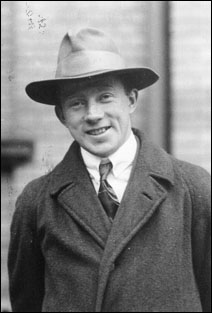The tools with which we are born and with which we come to know the world are our five sense organs - our eyes, ears, nose, tongue and skin. We often say that our eyes look out upon the world. But what intrigues me is that it isn't so much our eyes looking out as what is projected onto us, followed by our interpretation of what we think we have just sensed. Let's take our simple observation of a house plant. Light photons of varying frequency shine on the leaf of the plant. Many of these photons pass through the surface of the leaf and are absorbed by it.
In the beginning there was nothing, nor was anything lacking.
The paper was blank. We pick up the paint brush and create the scene...
The landscape, the wind whipping water into waves.
Everything depends upon the stroke of our brush.
Some thoughts concerning the nature of reality have teased my mind ever since I first read the following statement by Werner Heisenberg:
"... we have to remember that what we observe is not nature in itself but nature exposed to our method of questioning."
It would seem that we are not as much observers of an objective reality that exists "out-there", as we are the creators of a subjective reality that exists "in-here".
 The tools with which we are born and with which we come to know the world are our five sense organs - our eyes, ears, nose, tongue and skin. We often say that our eyes look out upon the world. But what intrigues me is that it isn't so much our eyes looking out as what is projected onto us, followed by our interpretation of what we think we have just sensed.
The tools with which we are born and with which we come to know the world are our five sense organs - our eyes, ears, nose, tongue and skin. We often say that our eyes look out upon the world. But what intrigues me is that it isn't so much our eyes looking out as what is projected onto us, followed by our interpretation of what we think we have just sensed.
Let's take our simple observation of a house plant. Light photons of varying frequency shine on the leaf of the plant. Many of these photons pass through the surface of the leaf and are absorbed by it. The frequencies of light which the leaf does not absorb bounce off, into our observing eyes. This light passes through the lens of our eyes where it is magnified, inverted, and then projected internally onto a matrix of receptors called the retina. There, a cascade of biochemical and electrochemical events soon follow, translating these incoming signals into a format that allows our mind to represent the color as green, as well as the shape of the leaf. We use the historical database of our minds to compare this leaf to others that we have known before. We quickly ascertain that the leaf is not a dangerous one, such as poison ivy.
We want to know more about this leaf, and so we gently touch it to find that its top surface feels smooth, and its bottom feels rough. We hear how the leaf sounds when a breeze comes by causing it to rub against other leaves. We can smell and even taste the leaf if we want. Ultimately, we use all our faculties to create a fuller image of it in our mind. This Maya-leaf seems so real.
Our first impression is that this leaf sensation exists as an external, independent and fixed reality because that's what our senses seem to indicate. But our five senses were probably never meant to know the truth of "what is". They seem to have evolved to allow us to survive, procreate and to help our offspring to do the same. But still we want to know more.
So, we build microscopes to "see" near and spectrometers that can "smell" and "taste" the contents of gas vapors and liquids in the leaf. We have devices that can "feel" surfaces for temperature and pressure, and we can use sound meters to detect and "hear" loudness and pitch. Now we are on a scientific path to the discovery of this Maya-leaf in its totality. We think that by creating more tools of increasing sensitivity that we will come to know "what is", the essence of that leaf.
But this assumption about reality seems to be at odds with our understanding of quantum science. What we eventually find on our scientific path is that underlying sub-atomic fabric of our world does not behave in a way that our minds can easily fathom. Fixed points of reality do not really exist in the pre-observational external world. What does appear are only quantum probabilities everywhere. Upon observation, these probabilities collapse and become our observed reality. We create and affect the nature of things simply by our awareness of them. Particles seem to scintillate in and out of existence before our eyes. It is as though we are creating the world as we go, as we experience it. We take input data and create a model of what we then assume is an external and objective reality.
But reality isn't actually known through our observations, or senses. Instead, it appears that all observers are much more like artists. We dip our mind's brush in the bucket of quantum probabilities around us to create our world. It would seem that we are all Masters of Maya from the very beginning.
